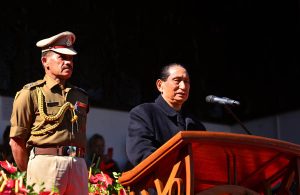Published on Dec 3, 2017
By EMN
Share
 SC Jamir addressing an event during the Hornbill Festival at the Naga Heritage village Kisama on Saturday.[/caption]
Kohima Bureau
Kisama, Dec. 2 (EMN): The second day of the ongoing 18th Hornbill Festival began with a cultural extravaganza with troupes from across the eight Northeast states displaying their rich traditional customs through dance and music.
The cultural event on Dec. 2 was put together by the North East Zone Cultural Centre (NEZCC). Governor of Odisha Dr. SC Jamir attended the event as its chief guest.
In his brief address to the revellers, Jamir, also a former chief minister of Nagaland, called December an important month for the Naga people. First, Nagaland being a Christian state, ‘December is very significant,’ he pointed out referring to the birth of Jesus Christ falling on the same month.
Secondly, he said, it was on Dec.1 in 1963 that the people of India and the ‘whole world’ came to know about the existence of the Naga people. It was a day when the Naga people proclaimed that they were also a sovereign people; they became part and parcel of ‘this great country India.’
With the Hornbill Festival having its roots during his time as the chief minister of Nagaland, Jamir gave a brief background of the festival: “It was our endeavour to bring all the tribes of Nagaland to a particular place, so that our friends from abroad and the rest of the country can see all the tribes in one place. It was therefore decided to observe the state foundation day (Dec.1) in Kohima town, thereafter, it was shifted here.”
The veteran politician appealed that the Naga people should not be left behind either in education or academic development; or governance, or by culture or tradition. He said that the Naga people have been endowed with ‘unique talents.’ The occasion calls for exhibition of the talents, he said.
The cultural features of the day included the Beril Nyijir Ngunu from Arunachal Pradesh; Moran Bihu from Assam; Pung, Thangta and Stick Dance from Manipur; Shad Suk Mynsiem from Meghalaya; Cheraw from Mizoram; Rai Silli from Sikkim; Sangrai Mog from Tripura and a special appearance by a Madhya Pradesh folk troupe.
SC Jamir addressing an event during the Hornbill Festival at the Naga Heritage village Kisama on Saturday.[/caption]
Kohima Bureau
Kisama, Dec. 2 (EMN): The second day of the ongoing 18th Hornbill Festival began with a cultural extravaganza with troupes from across the eight Northeast states displaying their rich traditional customs through dance and music.
The cultural event on Dec. 2 was put together by the North East Zone Cultural Centre (NEZCC). Governor of Odisha Dr. SC Jamir attended the event as its chief guest.
In his brief address to the revellers, Jamir, also a former chief minister of Nagaland, called December an important month for the Naga people. First, Nagaland being a Christian state, ‘December is very significant,’ he pointed out referring to the birth of Jesus Christ falling on the same month.
Secondly, he said, it was on Dec.1 in 1963 that the people of India and the ‘whole world’ came to know about the existence of the Naga people. It was a day when the Naga people proclaimed that they were also a sovereign people; they became part and parcel of ‘this great country India.’
With the Hornbill Festival having its roots during his time as the chief minister of Nagaland, Jamir gave a brief background of the festival: “It was our endeavour to bring all the tribes of Nagaland to a particular place, so that our friends from abroad and the rest of the country can see all the tribes in one place. It was therefore decided to observe the state foundation day (Dec.1) in Kohima town, thereafter, it was shifted here.”
The veteran politician appealed that the Naga people should not be left behind either in education or academic development; or governance, or by culture or tradition. He said that the Naga people have been endowed with ‘unique talents.’ The occasion calls for exhibition of the talents, he said.
The cultural features of the day included the Beril Nyijir Ngunu from Arunachal Pradesh; Moran Bihu from Assam; Pung, Thangta and Stick Dance from Manipur; Shad Suk Mynsiem from Meghalaya; Cheraw from Mizoram; Rai Silli from Sikkim; Sangrai Mog from Tripura and a special appearance by a Madhya Pradesh folk troupe.